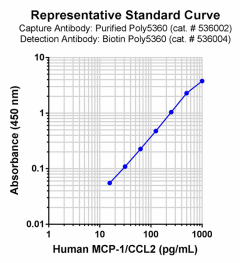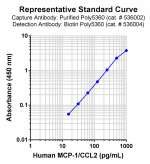- Clone
- Poly5360 (See other available formats)
- Regulatory Status
- RUO
- Other Names
- Monocyte chemoattractant protein-1 (MCP1), Monocyte chemoattractant and activating factor (MCAF), JE, Small inducible cytokine A2 (SCYA2), HC-11 (HC11), P6, Smooth muscle cell chemotactic factor (SMC-CF, SMCCF), CCL2, MCP-1, MCP1,CCL-2, MCP-1/CCL2
- Isotype
- Goat Ig
- Ave. Rating
- Submit a Review
| Cat # | Size | Price | Quantity Check Availability | Save | ||
|---|---|---|---|---|---|---|
| 536004 | 50 µg | 300€ | ||||
MCP-1, also known as CCL2, is a member of the CC chemokine family. It is widely expressed in endothelial cells, smooth muscle cells and monocytes in response to several atherogenic stimulants such as CD40 ligand, platelet derived growth factor (PDGF), interleukin-1β (IL-1β) and oxidized low density lipoprotein. In addition, MCP-1 has been implicated in monocytic infiltration of tissues during several inflammatory diseases, and has been implicated in macrophage-mediated tumor growth suppression in mice. MCP-1 has been shown to have direct effects on tumor cells in an autocrine and paracrine fashion in multiple cancers, including breast, lung, cervical, ovarian, and prostatic. In addition, MCP-1 plays a key role in the regulation of MMPs during transmigration.
Product DetailsProduct Details
- Verified Reactivity
- Human
- Antibody Type
- Polyclonal
- Host Species
- Goat
- Immunogen
- Recombinant protein
- Formulation
- Phosphate-buffered solution, pH 7.2, containing 0.09% sodium azide.
- Preparation
- The antibody was purified by affinity chromatography and conjugated with biotin under optimal conditions.
- Concentration
- 0.5 mg/ml
- Storage & Handling
- The antibody solution should be stored undiluted between 2°C and 8°C. Do not freeze.
- Application
-
ELISA Detection - Quality tested
- Recommended Usage
-
Each lot of this antibody is quality control tested by ELISA assay. For ELISA Detection applications, a concentration range of 0.01 - 0.5 µg/mL is recommended. To obtain a linear standard curve, serial dilutions of MCP-1 recombinant protein ranging from 1000 to 15.6 pg/mL is recommended for each ELISA plate. It is recommended that the reagent be titrated for optimal performance for each application.
- Application Notes
-
The biotinylated Poly5360 antibody is useful as the detection antibody in a sandwich ELISA assay, when used in conjunction with the purified Poly5360 antibody (Cat. No. 536002) as the capture antibody and Recombinant Human MCP-1 (CCL2) (ELISA Std.) (Cat. No. 565001).
- RRID
-
AB_2734497 (BioLegend Cat. No. 536004)
Antigen Details
- Structure
- CC chemokine, dimer, 13.8 kD (Mammalian)
- Distribution
-
Monocytes, vascular endothelial cells, smooth muscle, glomerular mesangial cells
- Function
- Upregulated by IL-1, TNF-α, PDGF, TGF-β
- Interaction
- Monocytes, basophils, T cells, NK cells, immature dendritic cells
- Ligand/Receptor
- CCR2, CCR5, CCR10, D6, possibly L-CCR
- Cell Type
- Endothelial cells, Monocytes
- Biology Area
- Cell Biology, Neuroinflammation, Neuroscience
- Molecular Family
- Cytokines/Chemokines
- Antigen References
-
1. Fitzgerald KA, et al. 2001. The Cytokine FactsBook; Academic Press, San Diego.
2. Bischoff SC, et al. 1992. J. Exp. Med. 175:1271.
3. Charo IF, et al. 1994. Proc. Natl. Acad. Sci. USA. 91:2752.
4. Jiang Y, et al. 1992. J. Immunol. 148:2423. - Gene ID
- 6347 View all products for this Gene ID
- UniProt
- View information about MCP-1 on UniProt.org
Related FAQs
- How many biotin molecules are per antibody structure?
- We don't routinely measure the number of biotins with our antibody products but the number of biotin molecules range from 3-6 molecules per antibody.
Other Formats
View All MCP-1 (CCL2) Reagents Request Custom Conjugation| Description | Clone | Applications |
|---|---|---|
| Purified anti-human MCP-1 (CCL2) | Poly5360 | ELISA Capture |
| Biotin anti-human MCP-1 (CCL2) | Poly5360 | ELISA Detection |
Compare Data Across All Formats
This data display is provided for general comparisons between formats.
Your actual data may vary due to variations in samples, target cells, instruments and their settings, staining conditions, and other factors.
If you need assistance with selecting the best format contact our expert technical support team.

 Login / Register
Login / Register 



















Follow Us